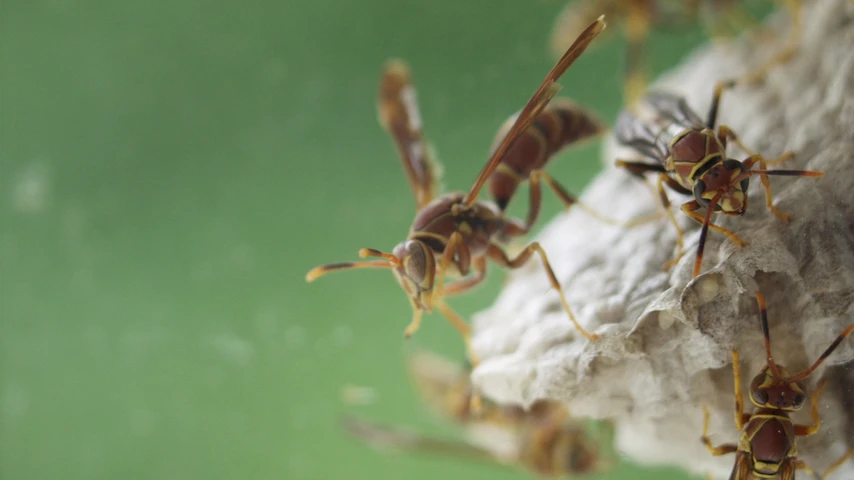All About Paper Wasps in Australia


The Australian Paper wasp is a common wasp species that inhabits homes, gardens and bushlands. One of the roughly 12,000 wasp species in Australia, Paper wasps play an important role as pollinator in the Australian ecosystem.
Paper wasps are native to Australia and are distinguished by their inverted cone-shaped nests, found under the eaves of houses and in trees.
Unlike bees, wasps can issue multiple painful stings at any one time. Wasps will aggressively swarm and attack if their nest is threatened. Paper wasps can give a painful sting and some people can respond with a severe allergic reaction.
Continue reading to find out more about Paper wasps (Polistes humilis) and how to treat their stings.
We also cover insect bites in the following first aid courses:
Head to our website to enrol in a course near you - we have locations all across Australia.
Australian Paper wasps have a reddish brown body with some yellow or orange bands.
Likewise, they have a slender build, narrow waist, and tend to range from 10 - 15 mm long.
They are commonly misidentified for Asian Paper wasps.
However, Australian Paper wasps tend to be smaller than their Asian counterpart and have less distinct banding.
Paper wasps live in heathlands, urban areas, and forests and woodlands throughout Australia, including:
Paper wasps spend their time building nests from wood fibres mixed with their saliva - which form a type of “paper”. A Paper wasp nest is an ingenious piece of organic architecture made of hexagonal cells that form a comb.
These cells hang in an upside-down cone-like structure from a stalk of pulp, often high in a tree or a house eave.
We run certified First Aid courses throughout all major Australia citys. Find a location near you.
Adult Paper wasps eat nectar, though they collect caterpillars to feed their larvae.
As such, they play an important part of pollinating along with keeping garden insects under control.
Paper wasps are not as aggressive as their European counterparts, however, they can be aggressive when defending their nests. There are more than 35 species of native Paper wasp, and each has a distinctive nest design.

Paper wasps are not venomous but will give a nasty sting if their nest is threatened. They attack as a swarm, and as Paper wasps give multiple stings it is important to exercise caution if you come across a nest.
Paper wasps are an important part of the native ecosystem, they are not considered a pest, but are more likely to keep other small annoying insects at bay.
If you are concerned about a Paper wasp colony, call a professional to remove it. Paper wasps tend to return to the location of their nests if it is simply destroyed.
If stung, most people will experience mild symptoms like pain, itching, and swelling at the sting site.
Allergic casualties, however, may experience more severe symptoms like:
Unlike a bee sting, a wasp sting will not remain in the skin. They can sting multiple times without dying. Paper wasps will swarm when their nest is under attack or threatened.
Care and treatment for a wasp sting goes like so:
The Australian Paper wasp is an important pollinator and contributor to the Australian ecosystem. While they are not as aggressive, nor considered a pest like the European Wasp, they can give a nasty sting if under threat.
If stung, most people will experience mild symptoms like pain, itching, and swelling at the sting site. Seek medical immediate medical help if any symptoms of anaphylaxis occur.
If you are interested in learning more about first aid for insect bites, enrol in one of our first aid courses:
Head to our website find a course near you - we have locations all across Australia.

March 11, 2025
Darwin, the tropical capital of Australia’s Northern Territory, is home to a rich diversity of wildlife - including an impressive array of spiders. From the sprawling webs of golden orb-weavers to the cryptic camouflage of trapdoor spiders, these arachnids play a vital role in the local ecosystem. While some may inspire fear, the majority are harmless and even beneficial, helping to control insect populations.

September 4, 2024
Cat bites, while often underestimated, can lead to serious health complications if not treated promptly and properly. Cats' mouths harbour a variety of bacteria that can cause infections in humans.

April 1, 2024
Encounters with wildlife can often be thrilling, but when it comes to the creature known as the drop bear, the experience can quickly turn dangerous. A sharp increase in recent attacks prompts the need for understanding proper first aid procedures in case of an attack.